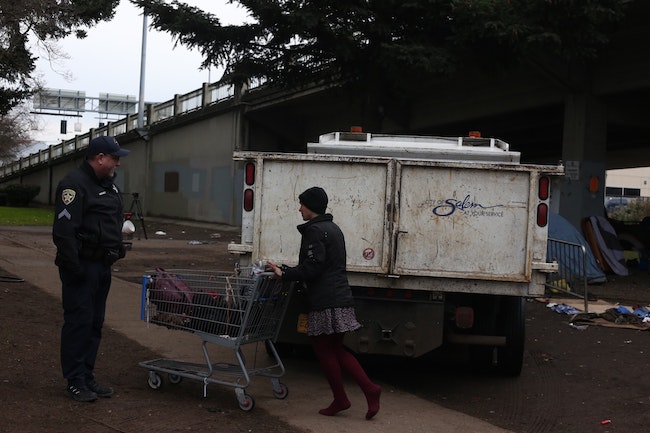 A homeless woman walks in front of a city of Salem public works vehicle during an eviction of a camp under the Marion Street Bridge in January. (Troy Brynelson/Salem Reporter)
A homeless woman walks in front of a city of Salem public works vehicle during an eviction of a camp under the Marion Street Bridge in January. (Troy Brynelson/Salem Reporter)
The city of Salem calculates that it spends about $5 million a year responding to homeless issues, according to a report obtained by Salem Reporter.
The report is the city’s first effort to summarize how much taxpayers are investing in the issue through city employee time and support. The report captured costs of police breaking up camps, as well as parks employees picking up litter and other city employees answering concerned emails or phone calls.
That figure does not include the ways Salem chooses to spend its money, such as running the Homeless Rental Assistance Program or giving subsidies to nonprofits.
“The goal here was to kind of try to dig out the costs that are just getting absorbed as part of our daily work,” said Urban Development Director Kristin Retherford, who hatched the idea for the assessment.
[ Help build Salem Reporter and local news – SUBSCRIBE ]
The report considered staff time spent in the city manager’s office and departments for urban renewal, police, fire and public works. The estimated total cost came to $5.2 million.
The numbers aren’t final, but Retherford said department directors stand by the findings.
“I don’t think it’s an overreported number,” Retherford said. “If anything, it’s an underreported number.”
DOCUMENT: Draft report on the costs of homelessness to city of Salem departments
Mayor Chuck Bennett made a similar case two weeks ago when talking with business owners, politicians and nonprofit leaders about homelessness – and he cited the same report.
“Remember what cities do. Cities do pretty basic things. We do fire, police, water, sewer, parks and plan,” Bennett told the crowd. “We are spending right now in excess of $5 million a year on this issue.”
The report took months of work by urban development officials, according to the records. Retherford said she came up with the idea around the start of the year after serving on task forces related to homelessness. Much of the work, however, was done by an intern from Willamette University.
To get the data, staff in non-emergency departments filled out time cards and noted the hours spent on homelessness. Police and fire did not use the time cards but instead used dispatch logs to calculate their time spent, Retherford said. Worker wages and benefits were then calculated and extrapolated into an annual cost.
Retherford finalized the three-page report, which she then sent to City Manager Steve Powers in September, according to the records.
The Salem Police Department claimed the biggest cost, according to the report. It reported spending $4.7 million per year on homelessness. That includes clearing homeless camps but also “regular activities related to general police work.”
“Anecdotally, people experiencing homelessness are increasingly taking up more officers’ time,” the report said.
After police, the Salem Fire Department incurred the second highest cost at nearly $260,000 a year. Firefighters respond to accidents, injuries, extreme cold, and other medical emergencies. The report said the number may be underreported.
“Fire does not denote housing status on their calls and thus the types of calls as well as costs are generalized, making underreporting likely,” the report said.
Public works incurred the third-highest cost, the report said, spending about $206,000 a year. Agency employees clean homeless camps along riverbanks, clean restroom facilities, clean under bridges and more.
“The time they spend cleaning up storm areas or bathrooms or whatever, it becomes sort of a hidden cost,” Retherford said. “Their primary job is not to address homelessness.”
Retherford said she’s not sure if the city would continue doing such reports, but said the first one could serve as a valuable baseline. She compared it to the annual point-in-time count, which attempts to count every unsheltered person living in an area. Neither report can be 100% accurate, but over time would provide another perspective, she said.
“To me, this is just the first go of something that can be repeated periodically,” Retherford said.
Have a tip? Contact reporter Troy Brynelson at 503-575-9930, [email protected] or @TroyWB.
Related coverage:
Salem City Council approves sidewalk conduct ordinance without sit-lie aspect (Nov. 25)
With homelessness an issue, Salem residents ‘less optimistic’ about city’s future (Oct. 14)
Union Gospel Mission, micro-apartments eyed for $750,000 city grants (May 29)









